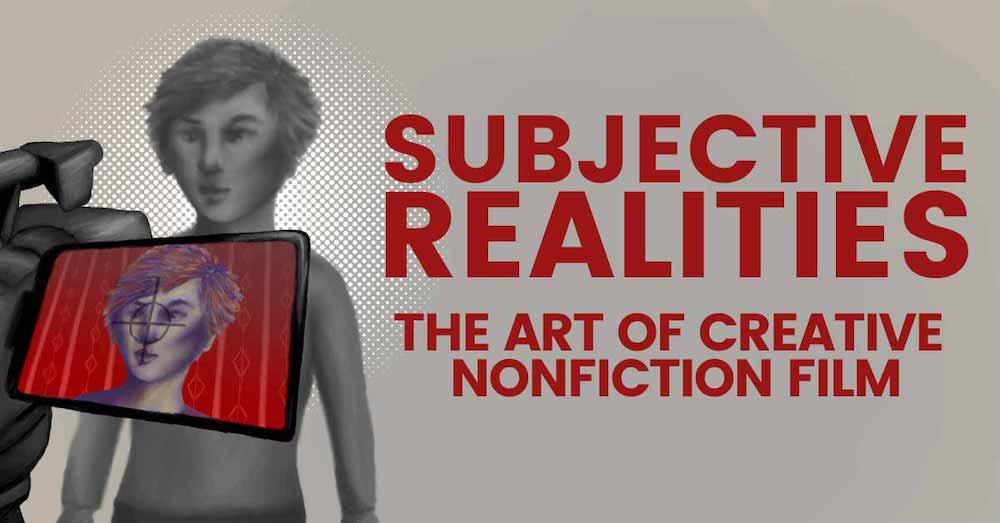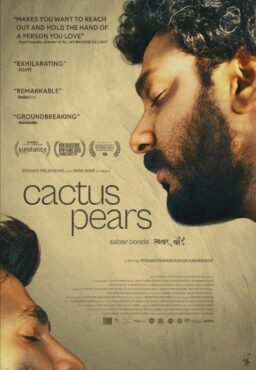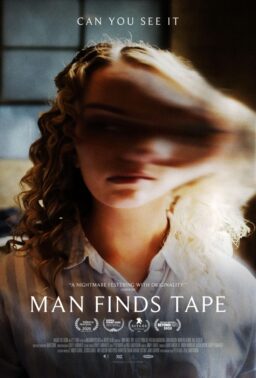The below is the introduction for the new ebook Subjective realities: The art of creative nonfiction film, which is being released today, August 20, by Seventh Row Publishing.
To purchase the ebook, click here.
Foreword for Subjective realities: The art of creative nonfiction film
Work on Subjective realities began just over a year ago, on May 3rd 2020, a few months into a global pandemic we’re still living through. Seventh Row Editor-in-Chief Alex Heeney and I, the co-editors of this book, came up with Lockdown Film School, a series of livestreamed conversations between filmmakers over Zoom. Instead of Q&As with a single filmmaker, we figured that something new and exciting might emerge if we, instead, paired two filmmakers whose work shares similarities. The very first session was on creative nonfiction, with Penny Lane and Carol Nguyen. We left that Zoom call inspired; Lane and Nguyen talked about busting convention, finding new ways to tell stories, and the therapeutic properties of filmmaking. Alex and I immediately messaged each other about fast-tracking a book on creative nonfiction, which we had only vaguely talked about in the past.
It’s poignant that this book’s journey began with Penny Lane, because its title also started with her, several years earlier. We’ve used the term ‘creative nonfiction’ since 2016, when Alex interviewed Lane at Sundance about her film NUTS!, an animated documentary that purposely lies to its audience, in the spirit of its charlatan subject. Inspired by the world of literature, where the term originates, Lane told us, “To say that NUTS! is creative nonfiction is helpful, if people knew what that meant. It’s more descriptive than documentary. Somebody might say that this isn’t a documentary, and I’d know what they mean. It’s kind of not. It’s kind of a fiction film that just happens to have nonfiction elements. To say it’s creative nonfiction would be helpful to communicate to an audience what’s happening.” That interview was later published in our first book on documentary, In their own words: Documentary masters. Subjective realities is our second.
You might have heard terms like ‘hybrid documentary,’ ‘experimental documentary,’ ‘docufiction,’ and ‘meta-nonfiction’ used to describe documentaries that break away from the traditional, journalistic, talking head, info dump formula. We follow Lane’s lead in calling these films ‘creative nonfiction.’ The label applies to any documentary that embraces subjectivity, focusing just as much on why and how the filmmaker is exploring their subject than the subject itself. It’s any documentary that’s unafraid to manipulate facts if it’s in service of revealing the truth. In Part One of this book, National Film Board of Canada (NFB) Executive Producer David Christensen paraphrases a famous saying that “documentary is any motion picture that is susceptible to the question of [whether it] might be lying.” While more traditional documentaries are eager to obscure their susceptibility to ‘lies,’ creative nonfiction embraces that ambiguity as part of its storytelling.
Subjective realities is one of the first book-length studies on the contemporary landscape of creative nonfiction — focusing primarily on films from the past ten years, through interviews and essays. In that time, creative nonfiction has changed immensely. That’s not to say that documentarians weren’t innovating before; the forebears to the filmmakers interviewed in this book include legends, such as Chantal Akerman, Jean Luc Godard, Werner Herzog, Abbas Kiarostami, Chris Marker, the Maysles brothers, Agnès Varda, Peter Watkins, and Frederick Wiseman.
The difference in the last decade is that, more and more, innovative approaches to nonfiction are being embraced by mainstream film discourse. While in 1988, Errol Morris’s The Thin Blue Line was disqualified as a documentary by the Academy Awards because it featured reenactments, the establishment has recently opened its arms to docs that somewhat break the mould. Best Documentary Oscar nominations still mostly go to info dump issue films. But in the past few years, subjective, stylised, and personal documentaries like Time (Garrett Bradley, 2020), Minding the Gap (Bing Liu, 2018), Hale County This Morning, This Evening (RaMell Ross, 2018), and Strong Island (Yance Ford, 2017) were nominated, too. Perhaps more crucially, streamers have started distributing and even producing creative nonfiction, such as Netflix offering Kirsten Johnson the kind of budget most documentary filmmakers could only dream of to make Dick Johnson is Dead (2020).
Of course, that doesn’t mean nonfiction filmmakers aren’t still struggling to get funding and distribution. Big streamers like Netflix, Amazon, and Apple releasing a few high profile creative documentaries a year means that the questions those films provoke are being asked more widely. However, especially in places like the United States, with few public funding bodies, it’s still hard to get a creative documentary made if it’s not an ‘issue film.’ Streamers are only supporting a few films a year; they might start a conversation, but they can’t lift up an entire industry.
In Subjective realities, we explore some of the significant nonfiction filmmakers and films of the past ten years, and explain how their films get made. Through the words of filmmakers like Robert Greene, Kirsten Johnson, Mina Shum, Gillian Armstrong, Zia Anger, Joe Bini, Cheryl Foggo, and Penny Lane; and essays on films by Chantal Akerman, Ava DuVernay, and Miguel Gomes, we paint a picture of the contemporary creative nonfiction landscape. This is by no means a comprehensive book, and it is admittedly biased toward American and Canadian films, although not lacking in some representation of world cinema. We discuss some of the most significant nonfiction filmmakers working today and elided some others, and we’ve featured some total newcomers whom we think are doing interesting things. Rather than a catalogue of every nonfiction filmmaker you should have on your radar, Subjective realities aims to highlight a few trends emerging in contemporary creative nonfiction and explore them through the lens of a few films and filmmakers.
Crucially, Part One of this book features a case study on funding nonfiction, in which we interview Sundance Director Tabitha Jackson, who discusses the fickle support for documentary in the US; and David Christensen, who illuminates the more robust funding structures that exist in Canada through the National Film Board (NFB). This sets the stage for the rest of the book, which features a number of NFB films (Ninth Floor, Mina Shum, 2015; The Road Forward, Marie Clements, 2017; Wintopia, Mira Burt-Wintonick, 2019; John Ware Reclaimed, Cheryl Foggo, 2020), a number of films produced or distributed by Netflix (Dick Johnson is Dead; 13th, Ava DuVernay, 2016; Evelyn, Orlando von Einsiedel, 2018; Casting JonBenet, Kitty Green, 2017), and a number of films that found other ways to get funded, many with great difficulty. Part Six, the final part of the book, also looks at films that were made with no budget, and asks what nonfiction could look like if we embraced films that weren’t produced by traditional means.
Any filmmaker or film fan, even those focused on fiction storytelling, could learn a lot from nonfiction filmmaking practice. One thing that’s consistent across all the filmmakers interviewed in this book is their unfailing curiosity. Those who work in creative nonfiction are constantly asking themselves questions: Why am I making this film? Is my filmmaking practice harmful or healing? Does it benefit the audience to know who’s behind the camera? Why restrict myself to preconceived cinematic rules when the best way to tell this story is somewhere in the undefinable space between fiction and nonfiction?
In the spirit of creative nonfiction, we’ve titled all six sections of Subjective realities as questions: What is creative nonfiction? Where is the line between fiction and reality? How can nonfiction reclaim history? How can nonfiction paint a portrait of a person? Does nonfiction filmmaking have the power to heal? Can creative nonfiction change our conception of cinema? They’re not there to be answered definitively, but to be explored, as part of an ongoing discussion. I hope that you’ll find Subjective realities to be a valuable contribution to that conversation.
Orla Smith, Executive Editor of Seventh Row
—-
Subjective realities: The art of creative nonfiction is a vital new exploration of the spectrum between fiction and nonfiction in documentary filmmaking.
Join Seventh Row’s editors, along with acclaimed filmmakers such as Kirsten Johnson, Robert Greene, Mina Shum, Joe Bini, Zia Anger, and Gillian Armstrong, to dive into the world of contemporary creative nonfiction.
ABOUT SEVENTH ROW:
Seventh Row is an online Canadian non-profit publication dedicated to helping viewers engage in political conversations through the lens of cinema. We’re invested in how film can be a catalyst to help people understand and think about social structures and social change.
Seventh Row releases highly-focused ebooks every year, each on a film, director, or theme in cinema they are passionate about. Through in-depth interviews and well-researched essays, they demystify the myriad technical choices behind great films.
Seventh Row is supported entirely by ebook sales, memberships, and donations.
WHERE TO FIND SEVENTH ROW:
Website: http://seventh-row.com
Podcast: https://seventh-row.com/category/podcasts/
Twitter: https://twitter.com/SeventhRow
Facebook: https://www.facebook.com/TheSeventhRow/
Instagram: https://instagram.com/SeventhRow











